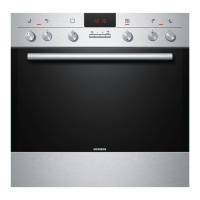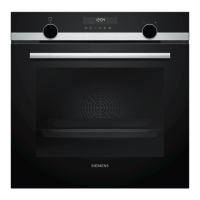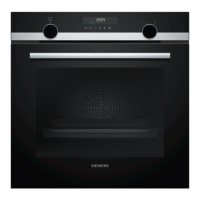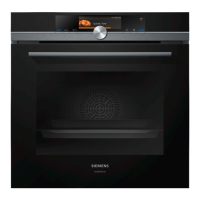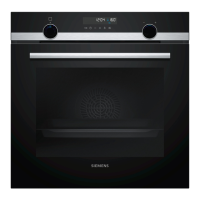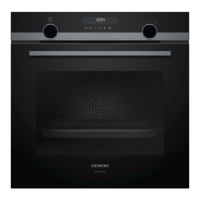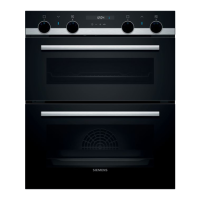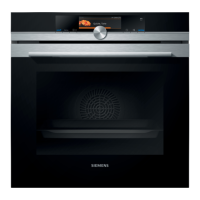en Familiarising yourself with your appliance
34
Symbol Type of heating or
function
Temperature or setting Use
Grill, small area Grill settings:
1 = low
2 = medium
3 = high
Grill small amounts, e.g. steaks, sausages, toast and
pieces of fish. The centre part of the grill element be-
comes hot.
Full-surface grill Grill settings:
1 = low
2 = medium
3 = high
Grill flat items, such as steak, sausages or toast and
gratinate. The entire area below the grill element be-
comes hot.
Circulated air grill 50-280°C Roast meat, poultry and whole fish. The fan circulates
the hot air around the food.
Top/bottom heat
gentle
50-280°C For gently cooking selected types of food (e.g.meat, ve-
getables) on one level without preheating. The type of
heating is unsuitable for food that rises as it bakes
(e.g.bread). This type of heating is used to measure
both the energy consumption in the conventional mode
and the energy efficiency class.
Top/bottom heat-
ing
50-280°C Prepare cakes, bakes and lean joints. The heat is emit-
ted evenly from above and below.
Cleaning
→"Cleaning function", Page42
4.3 Cooking compartment
The functions in the cooking compartment make your
appliance easier to use.
Shelf positions
The cooking compartment has 5 shelf positions.
Always insert the accessory as far as it will go so that
the accessory does not touch the door panel. Slide the
accessory into the cooking compartment correctly.
Interior lighting
When you open the appliance door, the interior lighting
switches on. If the appliance door remains open, the
light switches off again after a short time.
In most operating modes, the interior lighting switches
on as soon as operation starts. Once the operation is
complete, this switches off.
Note:In "Top/bottom heat gentle" mode, the interior
lighting switches off automatically after ap-
prox.1minute. You can switch on the interior lighting
using .
Cooling fan
The cooling fan switches on and off as required. The
hot air escapes via the appliance door.
ATTENTION!
Covering the ventilation slots will cause the appliance
to overheat.
▶ Do not cover the ventilation slots.
To cool the cooking compartment more quickly after
operation, the cooling fan continues to run for a certain
period afterwards.
Appliance door
If you open the appliance door while the appliance is in
operation, this pauses operation. When you close the
door, the operation continues.
To ensure that the appliance door does not come into
contact with the fitted unit, the appliance door opens
slightly less than 90°.
Condensation
This section tells you how condensation is formed, how
you can prevent damage, and how you can prevent
condensation from forming.
When you are cooking food in the cooking compart-
ment, a lot of steam may form in the cooking compart-
ment. Since your appliance is extremely energy-effi-
cient, only a small amount of heat escapes during op-
eration. Due to the significant differences in temperat-
ure between the appliance interior and the external
parts of the appliance, condensation may build up on
the appliance door, the control panel or the front pan-
els of adjacent kitchen units. The formation of condens-
ation is a normal physical phenomenon.
In order to prevent damage, wipe away the condensa-
tion. If condensation collects in the drip trough, remove
the condensation with a sponge. An overflowing drip
trough may damage the fitted unit. Leave the appliance
to dry with the door open.
When you preheat the appliance, you reduce the build-
up of condensation.
